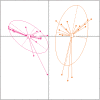Altered Gut Microbiota and Compositional Changes in Firmicutes and Proteobacteria in Mexican Undernourished and Obese Children
- PMID: 30386323
- PMCID: PMC6198253
- DOI: 10.3389/fmicb.2018.02494
Altered Gut Microbiota and Compositional Changes in Firmicutes and Proteobacteria in Mexican Undernourished and Obese Children
Erratum in
-
Corrigendum: Altered Gut Microbiota and Compositional Changes in Firmicutes and Proteobacteria in Mexican Undernourished and Obese Children.Front Microbiol. 2018 Nov 16;9:2693. doi: 10.3389/fmicb.2018.02693. eCollection 2018. Front Microbiol. 2018. PMID: 30515137 Free PMC article.
Abstract
Mexico is experiencing an epidemiological and nutritional transition period, and Mexican children are often affected by the double burden of malnutrition, which includes undernutrition (15.3% of children) and obesity (13.6%). The gut microbiome is a complex and metabolically active community of organisms that influences the host phenotype. Although previous studies have shown alterations in the gut microbiota in undernourished children, the affected bacterial communities remain unknown. The present study investigated and compared the bacterial richness and diversity of the fecal microbiota in groups of undernourished (n = 12), obese (n = 12), and normal-weight (control) (n = 12) Mexican school-age children. We used next-generation sequencing to analyze the V3-V4 region of the bacterial 16S rRNA gene, and we also investigated whether there were correlations between diet and relevant bacteria. The undernourished and obese groups showed lower bacterial richness and diversity than the normal-weight group. Enterotype 1 correlated positively with dietary fat intake in the obese group and with carbohydrate intake in the undernourished group. The results showed that undernourished children had significantly higher levels of bacteria in the Firmicutes phylum and in the Lachnospiraceae family than obese children, while the Proteobacteria phylum was overrepresented in the obese group. The level of Lachnospiraceae correlated negatively with energy consumption and positively with leptin level. This is the first study to examine the gut microbial community structure in undernourished and obese Mexican children living in low-income neighborhoods. Our analysis revealed distinct taxonomic profiles for undernourished and obese children.
Keywords: Firmicutes; Mexican children; microbiota; obesity; undernourished.
Figures






Similar articles
-
Gut Microbiota Composition in Undernourished Children Associated with Diet and Sociodemographic Factors: A Case-Control Study in Indonesia.Microorganisms. 2022 Aug 30;10(9):1748. doi: 10.3390/microorganisms10091748. Microorganisms. 2022. PMID: 36144350 Free PMC article.
-
Composition of gut microbiota in obese and normal-weight Mexican school-age children and its association with metabolic traits.Pediatr Obes. 2018 Jun;13(6):381-388. doi: 10.1111/ijpo.12262. Epub 2017 Dec 5. Pediatr Obes. 2018. PMID: 29388394
-
Nutrition and the Gut Microbiota in 10- to 18-Month-Old Children Living in Urban Slums of Mumbai, India.mSphere. 2020 Sep 23;5(5):e00731-20. doi: 10.1128/mSphere.00731-20. mSphere. 2020. PMID: 32968008 Free PMC article.
-
Mechanisms of cross-talk between the diet, the intestinal microbiome, and the undernourished host.Gut Microbes. 2017 Mar 4;8(2):98-112. doi: 10.1080/19490976.2016.1267888. Epub 2016 Dec 5. Gut Microbes. 2017. PMID: 27918230 Free PMC article. Review.
-
A Possible Perspective about the Compositional Models, Evolution, and Clinical Meaning of Human Enterotypes.Microorganisms. 2021 Nov 12;9(11):2341. doi: 10.3390/microorganisms9112341. Microorganisms. 2021. PMID: 34835466 Free PMC article. Review.
Cited by
-
Host diet shapes functionally differentiated gut microbiomes in sympatric speciation of blind mole rats in Upper Galilee, Israel.Front Microbiol. 2022 Nov 15;13:1062763. doi: 10.3389/fmicb.2022.1062763. eCollection 2022. Front Microbiol. 2022. PMID: 36458196 Free PMC article.
-
Tipping the Balance: Vitamin D Inadequacy in Children Impacts the Major Gut Bacterial Phyla.Biomedicines. 2022 Jan 26;10(2):278. doi: 10.3390/biomedicines10020278. Biomedicines. 2022. PMID: 35203487 Free PMC article.
-
Metatranscriptomic analysis to define the Secrebiome, and 16S rRNA profiling of the gut microbiome in obesity and metabolic syndrome of Mexican children.Microb Cell Fact. 2020 Mar 6;19(1):61. doi: 10.1186/s12934-020-01319-y. Microb Cell Fact. 2020. PMID: 32143621 Free PMC article.
-
Compound Fu brick tea modifies the intestinal microbiome composition in high-fat diet-induced obesity mice.Food Sci Nutr. 2020 Aug 31;8(10):5508-5520. doi: 10.1002/fsn3.1850. eCollection 2020 Oct. Food Sci Nutr. 2020. PMID: 33133553 Free PMC article.
-
Gut Microbiota Composition in Undernourished Children Associated with Diet and Sociodemographic Factors: A Case-Control Study in Indonesia.Microorganisms. 2022 Aug 30;10(9):1748. doi: 10.3390/microorganisms10091748. Microorganisms. 2022. PMID: 36144350 Free PMC article.
References
LinkOut - more resources
Full Text Sources

